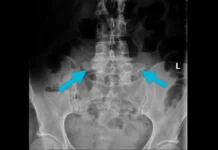The Negative Effects of Texting Posture on the Cervical Spine
The digital revolution has transformed our daily lives, but it has also introduced new challenges for our physical health, particularly regarding our postural habits. A common posture that has emerged with the rise of smartphones and electronic devices is the texting position, where the head is tilted forward to view the screen. Although this posture may seem harmless, it can have significant consequences on the health of the cervical spine.
When adopting the texting posture, the shoulders tend to round forward, thus causing flexion of the cervical spine. This position is often held for extended periods of time, whether when using a smartphone, tablet, or even laptop. The direct consequence of this constant tilt of the head is the creation of unpleasant muscular tensions.
The deep muscles of the neck and shoulders are particularly used in this posture. The resulting excess tension can lead to neck pain, both acute and chronic. Headaches, neck stiffness and even pain radiating to the shoulders are symptoms frequently associated with this prolonged texting posture.
When sitting or standing, the spine is designed to maintain natural alignment. The ears should ideally be aligned with the center of the shoulders to ensure balanced head weight distribution. In this neutral position, the average weight of the head exerts a force of approximately 5 kg through the neck muscles. However, when the head is tilted forward just 2 to 3 cm, as is often the case with texting posture, the weight of the head increases significantly.
At this stage, the weight placed on the neck muscles can reach around 30 kg. This sudden increase in load can lead to rapid muscle fatigue, increased tension, and ultimately structural problems in the cervical spine. The consequences can range from simple muscle discomfort to more serious problems such as spinal deformities.
To mitigate the negative effects of texting posture, it is crucial to adopt ergonomic practices. When using electronic devices, maintaining your head at eye level and avoiding leaning forward can help prevent excess strain. Regular breaks and neck and shoulder stretching exercises can also help relieve built-up pressure.
Raising awareness of the importance of maintaining good posture, even in the digital age, is essential to preventing health problems related to the cervical spine. Health professionals also recommend consulting a physiotherapist or occupational therapist for personalized advice on posture and suitable exercises.
In conclusion, although technology has simplified many aspects of our lives, it has also introduced new challenges to our physical well-being. Texting posture is a clear example of how our digital habits can impact our health. By adopting ergonomic practices and remaining aware of our posture, we can minimize the risk of muscle strain and neck pain associated with prolonged use of electronic devices.
Symptoms of abusive texting
Abusive texting, often associated with excessive use of text messages on smartphones, can cause various symptoms, both physical and psychological. Physically, users may experience pain in the fingers, hands, and wrists, often referred to as “text neck” or “tech neck,” resulting from prolonged head tilt during consultation. messages. Musculoskeletal disorders, such as tendinitis, can also occur due to the repetitive motions of typing.
On a psychological level, abusive texting can contribute to mental health problems. Anxiety from waiting for responses, stress from pressure to respond immediately, and reliance on notifications can all play a role in the negative psychological impact. Sleep disturbances can also occur if users are constantly stimulated by nighttime notifications, disrupting their rest.
Overuse of text messages can also lead to relationship problems. Misinterpretation of messages, lack of non-verbal communication and dehumanization of interactions can contribute to misunderstandings and tensions between individuals. Additionally, excessive texting can create a constant distraction, disrupting face-to-face interactions and harming the quality of relationships.
On a professional level, abusive texting can lead to decreased productivity. Constant interruptions from messages can disrupt workflow, affecting concentration and the ability to complete tasks efficiently. It can also contribute to feelings of burnout and increased stress at work.
It is important to recognize the symptoms of abusive texting to implement coping strategies and prevent possible health problems. This may include taking regular breaks, managing notifications to reduce interruptions, adopting ergonomic postures when using the phone, and creating clear limits on time spent on messages.
List of symptoms
- Neck pain: The tilted head position can cause pain in the neck area, especially at the back.
- Neck Stiffness: Constant muscle tension can lead to stiffness in the neck, limiting mobility.
- Headaches: Increased pressure on the neck and upper back muscles can trigger headaches, especially in the occipital region.
- Shoulder pain: The shoulders are often used to maintain posture, which can lead to pain in this area.
- Upper back pain: The hunched position can also cause upper back pain.
- Numbness or tingling: Compression of the nerves can cause numbness or tingling sensations in the arms and hands.
- Muscle fatigue: The muscles used to hold the head tilted can quickly fatigue, leading to a feeling of muscle fatigue.
- Visual Problems: A constant tilted head position can cause eye strain, vision problems and even eye-related headaches.
- General posture issues: Frequent use of texting posture can contribute to larger postural issues, such as slumped shoulders and increased curvature of the cervical spine.
- Sleep Disturbances: Discomfort and pain resulting from excessive texting can disrupt sleep, leading to insomnia problems or impaired sleep quality.
- Irritability and stress: Physical symptoms can contribute to an overall feeling of irritability and stress.
- Impact on mental health: Prolonged texting posture may contribute to decreased mental well-being due to irritability and stress associated with physical pain.
- Decreased productivity: Physical symptoms such as headaches and muscle fatigue can affect concentration and productivity at work or in other activities.
- Impaired quality of life: Constant neck pain can lead to impaired quality of life, limiting participation in social or leisure activities.
- Impact on relationships: Physical and mental fatigue can influence social interactions, contributing to a decrease in participation in social events.
- Development of musculoskeletal disorders: Prolonged use of the texting posture can contribute to the development of musculoskeletal disorders, affecting the joints and muscles.
- Effects on respiratory health: The hunched position can restrict lung capacity, indirectly impacting breathing and respiratory health.
- Digestive issues: Poor posture can also impact the digestive system, contributing to problems such as constipation.
- Development of bad habits: Constant use of texting posture can encourage the development of bad postural habits that persist even outside of electronic device use.
- Technology Addiction: Excessive use of smartphones and electronic devices in the texting posture can contribute to increased reliance on technology, which can have implications for mental health and emotional well-being.
- Social isolation: Spending long periods of time hunched over an electronic device can lead to social isolation, as the person may be less engaged in face-to-face social interactions.
- Impaired vision: In addition to vision problems associated with eye fatigue, prolonged use of electronic devices can contribute to long-term vision problems.
- Impact on sleep quality: Prolonged exposure to blue light from screens can disrupt the sleep cycle, affecting the quality and duration of rest.
- Development of postural disorders: Frequently adopting the texting posture can contribute to more general postural problems, affecting the spine and other parts of the body.
- Job Consequences: If the misuse of electronic devices occurs during work hours, it can have implications for productivity and job performance.
- Technology Stress: Constant use of electronic devices can contribute to technology stress, characterized by information overload and constant pressure to stay connected.
- Attention Deficit: Frequent use of texting posture can be associated with constant distractions, which can affect the ability to concentrate on important tasks.
- Impact on adolescent mental health: Adolescents who frequently use texting may be more likely to develop mental health problems, such as anxiety and depression, linked to social pressure and online comparison.
- Decreased Academic Productivity: Prolonged use of smartphones for activities such as texting can interfere with studying, leading to decreased academic productivity.
- Accident Risks: Distraction caused by using smartphones while walking or driving can increase the risk of accidents and injuries.
- Development of musculoskeletal problems: In addition to neck and shoulder pain, constant use of texting posture can contribute to the development of more extensive musculoskeletal disorders, affecting the back, arms and wrists.
- Effects on Respiratory Health in Children: Early adoption of the texting posture can influence breathing in children, particularly when they are absorbed in screens for extended periods of time.
- Interpersonal tensions: Excessive smartphone use, including texting posture, can create tension in interpersonal relationships, especially when attention is constantly diverted to electronic devices.
- Self-Confidence Issues: Constant comparisons to other people on social media, coupled with the use of texting posturing, can contribute to self-esteem and self-confidence issues.
- Environmental impact: The production and use of smartphones has environmental implications, contributing to electronic waste and energy consumption.
- Effects on Reproductive Health: Studies suggest that radiation from smartphones, when used in the pocket, could have potential effects on male reproductive health.
- Increased sedentary lifestyle: Prolonged use of texting posture can contribute to a sedentary lifestyle, which can lead to long-term health problems such as obesity and cardiovascular disease.
Impact of texting on the shoulders
Frequent cell phone use may seem harmless, but it can have significant consequences on postural health, particularly in the shoulders and back. Initially light, the mobile phone can quickly become a significant load for the arms that support it.
In reality, it is not the phone that becomes heavy, but the muscles and joints required to maintain this prolonged posture. The shoulders, in a constant effort to support the weight of the phone, tend to round, creating a forward bend. This postural deformation can set in gradually over time.
This process can lead to plastic deformation, meaning that the altered posture becomes increasingly difficult to correct. The shoulders, accustomed to this curved position, will have difficulty finding their natural alignment backwards. This tendency to maintain a forward posture can also affect the spine, creating a pronounced lumbar curve.
The impact of this postural deformation goes beyond aesthetics. The consequences include lower back discomfort, resulting from the pressure exerted on the spine. These discomforts can become chronic and lead to more serious complications over time.
It is crucial to be aware of the effects of prolonged posture related to cell phone use and to adopt habits that preserve musculoskeletal health. Frequent breaks, muscle strengthening exercises, and attention to posture can help prevent harmful consequences. Early awareness and adjustments in behavior can play a vital role in maintaining healthy posture and preventing health problems associated with constant use of electronic devices.
List of impacts texting does on the shoulders
- Muscle tension: Forward hunched posture causes excessive tension in the muscles of the upper back and shoulders, especially the trapezius and rhomboid muscles.
- Shoulder Retroversion: The texting position can contribute to shoulder retroversion, where the shoulders tend to tilt forward rather than staying in line with the spine.
- Rounded shoulders: The tendency to round the shoulders during texting posture can cause postural deformity, characterized by shoulders slumped forward.
- Pressure on Joints: Pressure on the shoulders and shoulder joints can lead to increased stress, which can contribute to premature wear and tear and joint problems.
- Nerve Compression: The hunched position can put pressure on the nerves located in the shoulder area, causing sensations of numbness, tingling, or pain down the arms.
- Reduced mobility: Prolonged texting posture can lead to decreased shoulder mobility, limiting the ability to perform full movements.
- Pain and discomfort: Overworked muscles can become tight and tired, causing pain and discomfort in the shoulders.
- Impact on stability: Texting posture can compromise shoulder stability by affecting the balance between the muscles in the back and those in the front of the body.
- Thoraco-brachial outlet syndrome: A constantly hunched posture can contribute to the development of thoraco-brachial outlet syndrome, characterized by compression of blood vessels or nerves in the neck and shoulder area.
- Rotator cuff tendonitis: Texting posture can increase pressure on the rotator cuff, a group of muscles and tendons around the shoulder, increasing the risk of tendinitis.
- Bursitis: Prolonged use of the texting posture can irritate the bursae around the shoulders, leading to an inflammation called bursitis.
- Altered shoulder biomechanics: Constantly leaning can alter the natural biomechanics of the shoulder, affecting the way it moves and functions.
- Muscle imbalance: A frequently hunched posture can contribute to a muscular imbalance between the front and back muscles, impacting shoulder stability.
- Acromioclavicular Joint Problems: Texting posture can put increased pressure on the acromioclavicular joint, potentially contributing to problems such as osteoarthritis.
- Impacts on the cervical spine: Poor shoulder posture can impact the cervical spine, contributing to problems such as headaches and neck pain.
- Effects on breathing: A slumped posture can restrict respiratory capacity by limiting thoracic expansion.
- Development of postural problems: Texting posture can contribute to broader postural problems, affecting the spine and shoulders.
- Impact on the nervous system: Texting posture can put pressure on the nerves in the cervical spine, which can lead to problems such as tingling, numbness, and feelings of weakness in the arms.
- Development of temporomandibular joint (TMJ) disorders: Prolonged forward head position can influence the jaw, contributing to the development of temporomandibular joint disorders.
- Increased risk of migraines and tension headaches: Muscle tension resulting from texting posture can increase the risk of migraines and tension headaches.
- Effects on blood circulation: Compression on blood vessels in the neck can impede circulation, which can impact cardiovascular health.

Rules to follow
For those who indulge in excessive use of text messages, adopting clear rules can help promote a healthier and more balanced use of this form of communication. First of all, it is essential to establish dedicated time limits for viewing messages, in order to prevent constant distraction and promote increased concentration in other aspects of daily life. Turning off notifications can also be beneficial, reducing the pressure to respond immediately and easing the anxiety associated with waiting for responses.
It is crucial to cultivate healthy sleep habits by avoiding excessive phone use before bed. Blue light emitted from screens can disrupt the sleep cycle, leading to sleep disturbances. Establishing a period of disconnection before bed can promote better rest.
Creating rules around response frequency can also help reduce stress related to expectations of immediate responses. It’s important to recognize that not everyone is available at all times, and respecting the need for personal time is crucial for healthy interactions.
When it comes to relationships, it is beneficial to avoid misunderstandings by opting for more direct communications when the complexity of the message warrants it. When dealing with delicate topics or important conversations, favoring discussions in person or by telephone can avoid misinterpretations often associated with text messages.
Taking regular breaks during the day to disconnect from the phone can also promote more balanced use. These moments of disconnection can contribute to better concentration at work, richer social interactions and a reduction in the stress associated with constant connectivity.
List of rules to follow
- Establish regular breaks: Incorporate short breaks every 20 to 30 minutes when using electronic devices. This helps change posture, relax muscles and prevent fatigue.
- Practice stretching exercises: Adopt stretching exercises for your shoulders, neck and upper back to prevent muscle stiffness caused by prolonged standing.
- Maintain a neutral posture: Keep your phone at eye level to avoid lowering your head. Maintain a neutral spine and shoulder posture to reduce muscle tension.
- Use ergonomic stands: If possible, use stands to raise your electronic devices to eye level. This helps maintain a more natural posture.
- Practice muscle-strengthening exercises: Strengthen the muscles in your back, shoulders and neck to support healthy posture. Targeted exercises can help prevent muscle imbalances.
- Pay attention to workplace ergonomics: If you work at a computer, make sure your desk, chair, and monitor are adjusted to promote correct posture.
- Avoid excessive use: Limit the time spent on electronic devices and adopt habits that promote mindful use.
- Educate about posture: Educate children and adolescents about the importance of healthy posture from an early age. Encourage them to adopt good habits from the start.
- Consult a healthcare professional: If you experience persistent pain, stiffness or postural problems, consult a healthcare professional, such as a physiotherapist, for personalized advice.
- Be aware of screen lighting: Reduce exposure to blue light from screens, especially before bedtime, to preserve the quality of sleep.
- Adopt the 20-20-20 rule: To relieve eye strain, practice the 20-20-20 rule. Every 20 minutes, look at something at least 20 feet (about 6 meters) away for at least 20 seconds.
- Variety in activities: Incorporate variety into your daily activities. Alternate between using electronic devices, walking, and other tasks to avoid postural monotony.
- Adjust brightness and font size: Change your screen settings to ensure comfortable brightness and font size. This reduces visual strain and encourages better posture.
- Limit use before bed: Reduce use of electronic devices at least an hour before bed to promote quality sleep.
- Opt for active breaks: Take advantage of breaks to do light exercises or stretches. This stimulates blood circulation and prevents muscle stagnation.
- Invest in ergonomic furniture: If possible, choose ergonomic office furniture that supports correct posture and reduces pressure on the shoulders and back.
- Practice body awareness: Become aware of your posture throughout the day. Do regular checks to ensure you are maintaining a neutral position.
- Encourage overall physical activity: Encourage an active lifestyle outside of using electronic devices. General physical activity contributes to overall musculoskeletal health.
- Educate on self-adjustment: Learn how to adjust your electronic devices in a way that makes them more ergonomically friendly. This includes adjusting the height and angle of the screens.
- Practice mindful breathing: Incorporate moments of deep, mindful breathing to release muscle tension and promote relaxation.
- Use posture reminder apps: Specific apps can remind you to check and correct your posture throughout the day, helping to develop postural awareness.
- Promote standing posture: If possible, incorporate periods of standing work by using a height-adjustable desk. This reduces pressure on the lower back and promotes better posture.
- Practice yoga or Pilates: These disciplines can strengthen core muscles, improve flexibility and promote balanced posture.
- Avoid holding the phone between your shoulder and ear: This habit can create muscle tension in the neck and shoulders. Instead, use hands-free devices.
- Adjust the seat height in the car: If you frequently use your phone while driving, make sure the seat is adjusted to maintain a comfortable, natural posture.
- Adopt relaxation techniques: Stress can influence posture. Incorporate relaxation techniques, such as meditation or deep breathing, to reduce muscle tension.
- Pay attention to the position of the backpack: If you often carry a backpack, make sure it fits properly and carry it on both shoulders to distribute the weight evenly.
- Prioritize active breaks at work: Use breaks to take short walks or stretches. This stimulates circulation and helps prevent muscle stiffness.
- Invest in an ergonomic pillow: To promote good posture while sleeping, choose a pillow that supports the natural curvature of your neck.
- Encourage outdoor activities: Spend time outdoors, whether walking, cycling, or other activities, to promote a variety of movement and reduce a sedentary lifestyle.
Stretch to do
Stretching can play a vital role in preventing posture problems related to prolonged use of electronic devices. Here are some specific stretches that target commonly affected areas, like the neck, shoulders, and upper back:
- Neck stretch:
- Sitting or standing, slowly tilt your head to one side, bringing your ear toward your shoulder. Hold the position for 15 to 30 seconds.
- Repeat on the other side.
- Trapezius stretching:
- Sitting or standing, tilt your head to one side while tilting your chin slightly toward your chest. You should feel the stretch along the side of your neck and upper back.
- Hold the position for 15 to 30 seconds.
- Repeat on the other side.
- Shoulder stretch:
- Extend your right arm in front of you.
- Use the left arm to gently pull the right arm toward the chest.
- Hold the position for 15 to 30 seconds.
- Repeat with the other arm.
- Upper back stretch:
- Sit in a chair without armrests.
- Cross your arms in front of you and bend your upper body slightly forward.
- You should feel the stretch between your shoulder blades.
- Hold the position for 15 to 30 seconds.
- Hip flexor stretch:
- Get on your knees with your knees apart.
- Lower your torso toward the floor by extending your arms in front of you.
- Stretch your arms as much as possible, while holding the position for 15 to 30 seconds.
- Stretching the lower back muscles:
- Lie on your back.
- Bring one knee toward your chest while keeping the other leg extended.
- Hold the position for 15 to 30 seconds.
- Repeat with the other leg.
References
- Moretti A, Menna F, Aulicino M, Paoletta M, Liguori S, Iolascon G. Characterization of Home Working Population during COVID-19 Emergency:A Cross-Sectional Analysis. Int J Environ Res Public Health. 2020;17(17):6284. doi:10.3390/ijerph17176284. [PMC free article] [PubMed] [Google Scholar]
- Singh S, Kaushal K, Jasrotia S. Prevalence of forward head posture and its impact on the activity of daily living among students of Adesh University –A cross-sectional study. Adesh Univ J Med Sci Res. 2020;2(2):99–102. doi:10.25259/AUJMSR_18_2020. [Google Scholar]
- Guan X, Fan G, Wu X, Zeng Y, Su H, Gu G, et al. Photographic measurement of head and cervical posture when viewing mobile phone:a pilot study. Eur Spine J. 2015;24(12):2892–8. doi:10.1007/s00586-015-4143-3. [PubMed] [Google Scholar]
- Loh K, Redd S. Understanding and preventing computer vision syndrome. Malays Fam Physician. 2008;3(3):128–30. [PMC free article] [PubMed] [Google Scholar]
- Salahzadeh Z, Maroufi N, Ahmadi A, Behtash H, Razmjoo A, Gohari M, et al. Assessment of forward head posture in females:observational and photogrammetry methods. J Back Musculoskelet Rehabil. 2014;27(2):131–9. doi:10.3233/BMR-130426. [PubMed] [Google Scholar]
- Bonney RA, Corlett EN. Head posture and loading of the cervical spine. Appl Ergon. 2002;33(5):415–7. doi:10.1016/s0003-6870(02)00036-4. [PubMed] [Google Scholar]
- Gonzalez HE, Manns A. Forward head posture:its structural and functional influence on the stomatognathic system, a conceptual study. Cranio. 1996 Jan;14(1):71–80. doi:10.1080/08869634.1996.11745952. [PubMed] [Google Scholar]
- Lee JH. Effects of forward head posture on static and dynamic balance control. J Phys Ther Sci. 2016;28(1):274–7. doi:10.1589/jpts.28.274. [PMC free article] [PubMed] [Google Scholar]
- Weon JH, Oh JS, Cynn HS, Kim YW, Kwon OY, Yi CH. Influence of forward head posture on scapular upward rotators during isometric shoulder flexion. J Bodyw Mov Ther. 2010;14(4):367–74. doi:10.1016/j.jbmt.2009.06.006. [PubMed] [Google Scholar]
- Lee KJ, Han HY, Cheon SH, Park SH, Yong MS. The effect of forward head posture on muscle activity during neck protraction and retraction. J Phys Ther Sci. 2015;27(3):977–9. doi:10.1589/jpts.27.977. [PMC free article] [PubMed] [Google Scholar]
- Costa D, Vitti M, De Oliveira Tosello D. Electromyographic study of the sternocleidomastoid muscle in head movements. Electromyogr Clin Neurophysiol. 1990;30(7):429–34. [PubMed] [Google Scholar]
- Mousavi-Khatir R, Talebian S, Toosizadeh N, Olyaei GR, Maroufi N. Disturbance of neck proprioception and feed-forward motor control following static neck flexion in healthy young adults. J Electromyogr Kinesiol. 2018;41:160–7. doi:10.1016/j.jelekin.2018.04.013. [PubMed] [Google Scholar]
- Tanveer F, Shahid S, Hafeez MM. Effect of Forward Head Posture on Neck Disability and Level of Stress among Undergraduate Students. Isra Med J. 2018;10(2):78–80. [Google Scholar]
- 14. Lee MY, Lee HY, Yong MS. Characteristics of cervical position sense in subjects with forward head posture. J Phys Ther Sci. 2014;26(11):1741–3. doi:10.1589/jpts.26.1741. [PMC free article] [PubMed] [Google Scholar]
- Kong YS, Kim YM, Shim JM. The effect of modified cervical exercise on smartphone users with forward head posture. J Phys Ther Sci. 2017;29(2):328–31. doi:10.1589/jpts.29.328. [PMC free article] [PubMed] [Google Scholar]


























